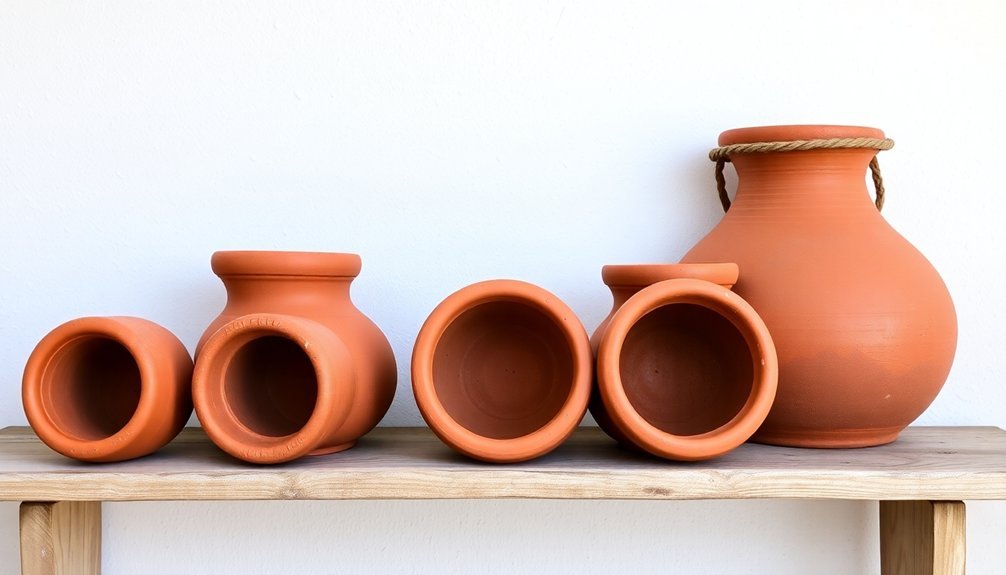The three best clay pots for long-term food storage include traditional Indian curd vessels, large cylindrical cooling storage pots, and clay food preservation containers. You'll find curd vessels perfect for yogurt storage, lasting 3-4 days while maintaining beneficial probiotics. Cylindrical cooling pots use evaporative cooling to keep produce fresh up to four times longer, making them ideal for fruits and vegetables. Clay preservation containers, like the Kangina style, can preserve fruits for months through controlled atmosphere storage. Each option offers unique benefits for food preservation, and there's much more to discover about their remarkable capabilities.
Traditional Indian Clay Curd Vessels

India's traditional clay curd vessels have stood the test of time, offering a natural and effective way to prepare and store homemade yogurt. When you're setting curd in these pots, you'll benefit from their exceptional insulating properties that maintain the perfect temperature for fermentation.
The clay's natural alkalinity balances the curd's acidity, resulting in a sweeter, less sour product that stays fresh longer. These vessels can store curd safely for 3-4 days without any risk of spoilage.
Before you start using your clay pot, you'll need to prepare it properly. Soak it overnight in room-temperature water, then dry it thoroughly. You should clean it gently with hot water, avoiding harsh detergents that can damage the surface.
For maintenance, use only coconut or nylon brushes to protect the terracotta.
You'll notice that curd set in clay pots is remarkably thick and creamy, thanks to the clay's porous nature that absorbs excess moisture. These vessels also enrich your yogurt with essential minerals like calcium, magnesium, and iron.
They're completely non-toxic when made from unglazed, lead-free clay, making them a safe choice for daily use. The pots naturally cool their contents and preserve the probiotics and proteins that make yogurt such a healthy food choice.
Large Cylindrical Cooling Storage Pots
How can a simple clay pot design revolutionize food storage without electricity? Large cylindrical cooling storage pots use the power of evaporative cooling to keep your produce fresh longer.
You'll need two pots of different sizes – a smaller one that fits inside a larger one – with wet sand filling the gap between them. The containers feature chemical resistant properties similar to commercial food storage options.
When you place these pots in a shady, well-ventilated area and cover them with a damp cloth, the evaporation process can lower the internal temperature by up to 10°C below ambient conditions.
This cooling effect, combined with increased humidity, helps preserve your fruits and vegetables considerably longer – extending the life of leafy greens from one day to over four days.
To maintain ideal cooling performance, you'll need to keep the sand layer consistently wet and clean the pots regularly.
The design's effectiveness relies on proper maintenance and placement. You can construct this system using locally available materials, making it an accessible solution for areas without reliable electricity.
The benefits are substantial: you'll reduce food waste, save money on spoilage, and make fewer trips to the market while maintaining fresher produce for your household.
Clay Food Preservation Containers

Ancient clay pot preservation techniques offer remarkable capabilities for long-term food storage without modern technology. Using traditional kangina containers, made from clay and straw, you'll find that fruits like grapes can stay fresh for months or even years through passive controlled-atmosphere storage.
When choosing clay preservation containers, you'll need to reflect on safety factors carefully. Look for properly glazed pots to minimize heavy metal leaching, though you should still treat new pots by boiling water and cooking vegetables in them first. The viral social media demonstrated this preservation method reaching millions of viewers.
The preservation mechanism works by maintaining low oxygen levels and high CO2 concentrations, which slows down fruit metabolism while controlling moisture levels.
You'll find these containers particularly cost-effective since they don't require electricity. The clay-straw combination works by absorbing excess moisture while allowing minimal gas diffusion, creating an ideal environment for food preservation.
If you're in an area with limited access to modern refrigeration, you can rely on this time-tested method. When properly implemented, you'll benefit from reduced food waste and extended storage life for your fruits and vegetables, all while using locally available materials.
Frequently Asked Questions
How Long Does a Clay Pot Typically Last Before Needing Replacement?
Your clay pot can last 10+ years with proper care. You'll extend its lifespan by avoiding impacts, protecting it from extreme temperatures, and maintaining regular cleaning. Poor handling might require earlier replacement.
Can Clay Pots Be Safely Used in Refrigerators?
You shouldn't use clay pots in refrigerators. They're designed for evaporative cooling and don't work effectively in sealed, cold environments. The damp conditions could promote mold growth and lead to contamination of other foods.
What's the Best Way to Repair a Cracked Clay Pot?
You'll get the best results repairing your cracked clay pot using heat and oil treatment. Clean it, apply oil, heat at 250°F for 30 minutes, then let it rest for 12 hours to heal.
Are Clay Pots Safe to Use With Acidic Foods?
You'll need unglazed, 100% natural clay pots for acidic foods. They're generally safe but can leach minerals, so make certain your pot is certified and tested. Avoid sudden temperature changes to prevent cracking.
How Can You Tell if a Clay Pot Is Food-Grade Quality?
You'll know a clay pot is food-grade if it has FDA certification, comes from a reputable manufacturer with testing documentation, features a stable glaze, and doesn't leach metals when tested with acidic foods.
In Summary
You'll find clay pots offer a natural, eco-friendly solution for storing food long-term. By choosing between traditional Indian curd vessels, large cylindrical cooling pots, or dedicated preservation containers, you're investing in time-tested storage methods that keep food fresh without electricity. Whether you're storing grains, preserves, or fermented foods, these clay vessels will serve you well while adding a rustic charm to your kitchen.





Leave a Reply